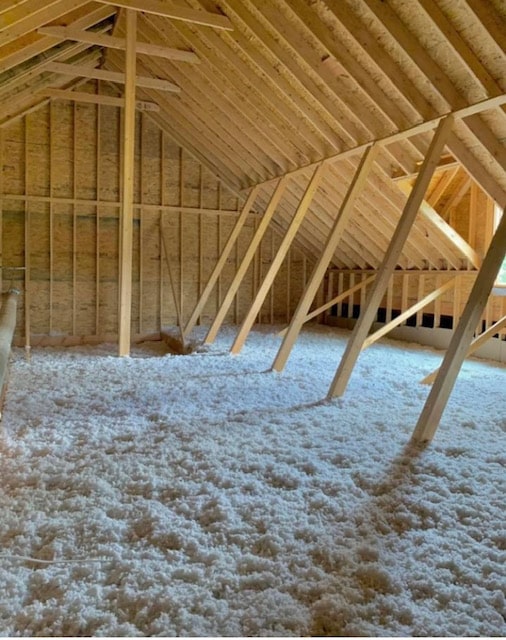Why Attic Insulation Matters for Energy Star ZERH Homes
Attic insulation can be more complicated depending on where you are in the country and your home’s design. In Minnesota, most homes have vented attics, which allows for using blown in loose-fill insulation—commonly considered one of the best insulation for attic spaces because it’s both effective and affordable.
This Energy Star Zero Energy Ready build will have 17″ of blown cellulose insulation installed to meet the ZERH R-60 requirement for the ceiling insulation. It is doubtful that any future upgrade to the insulation will be needed for this home. Somewhere between an R-60 and R-70, all thermal energy transfer stops. The bonus of using blown-in cellulose in the attic is that it is either recycled or a natural insulation.
Why Blown-In Cellulose is a Smart Choice
In a couple of years, the top layer of insulation will form a crust or shell over the top fluffy bulk of the insulation. This crust helps prevent air infiltration into the insulation, blown-in fiberglass insulation will not do that. Cellulose insulation can also mitigate moisture from any air leaks into the attic from the interior that would cause condensation in blown-in fiberglass insulation during the cold winter months.
Spray Foam vs. Blown-In: Conditioned Attics
Having worked in many attics, I have seen how well different attic insulation installations work and the pros and cons of the size of the attic. My favorite attics are the ones that are insulated at the underside of the roof deck, usually with either closed-cell or open-cell spray foam insulation. Not very common in Minnesota. This design creates a fully or partly conditioned space, which means the attic stays at a comfortable temperature. There is no insulation to crawl through! HVAC equipment and air ducts can be in this conditioned space for slab on grade homes. It’s required for Energy Star ZERH builds to have all HVAC equipment and air ducts in conditioned space, but it is definitely a more expensive option.
The Traditional Approach: Vented Attics with Blown-In Insulation
Next up is the giant vented attic with blown-in insulation. These giant attics with 10/12 roof pitches or higher have lots of space and are nice since there is room to stand up in and enough air volume to dissipate heat during the summer months. We could go into these attics even on a hot summer day, and the temperature inside the attic would only be slightly warmer than the outside air temperature. This is a more cost effective ceiling insulation solution then insulating under the roof deck.
Smart Roof Design for Energy Efficiency
This Energy Star ZERH rambler will have a standard 6/12 pitched roof with a vented attic. This is the best compromise in cost for this build. It will have a fair amount of attic space to help dissipate thermal loading on shingles and the roof deck from the hot summer sun. But the temp inside the attic can easily be in the triple digits on a hot summer day even though it is vented.
This is where the R-60 attic insulation is important. We want to keep that triple digit temp in the attic, not transfer into the living space. If the new homeowner opts for solar panels, they would help offset thermal loading besides providing power. The temp of the panels, which take the significant heat load, can easily reach 135 degrees. With the air space between the solar panels and the roof, the shingles will be at air temperature, which helps keep the attic temperature more reasonable, lowering the heat load on the attic insulation.
How to Insulate an Attic
Knowing how to insulate an attic depends on the attic type, home design, and climate zone. In vented attics (common in Minnesota), blown-in cellulose or fiberglass insulation is often the go-to method. It fills gaps easily and can be installed over existing insulation.
For unvented or conditioned attics, spray foam insulation applied directly to the underside of the roof deck is a top-performing option, though more costly. It’s especially effective in reducing air leakage and creating a tight building envelope.
Older Homes and Heat Gain Challenges
Older homes with less insulation in the attic even if the attic is vented suffer from heat gain from the hot attic. Thermal loading of the shingles and roof deck into the into the small attic raise the attic temp considerably! This a major issue in the sun belt areas of the US. With a 4/12 roof pitch on an average home there is little space to dissipate that thermal load through venting. With older ceiling insulation standards a 130 degree attic is transferring a lot of heat load into the living space making the AC work a lot harder then needed.
Is R-60 Worth It?
The cost difference between R-49 and R-60 for this 1400 sq ft Energy Star ZERH build is about $200. This makes the addition of extra blown-in insulation to a vented attic a highly cost-effective and energy-efficient upgrade. The value it brings to your home and the comfort it provides make it a worthwhile investment.
Up next, windows! The biggest thermal bridging problem in any building!
